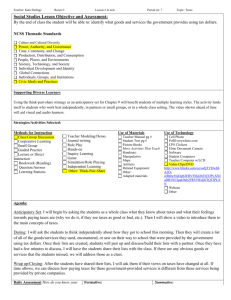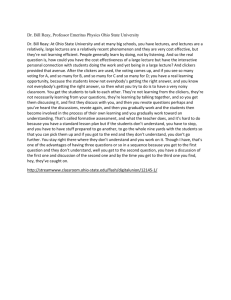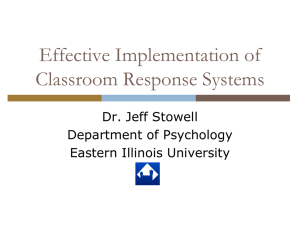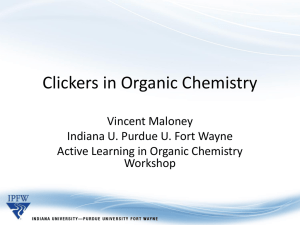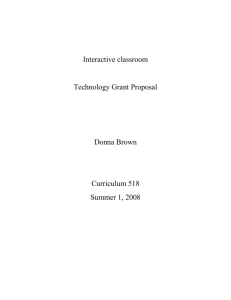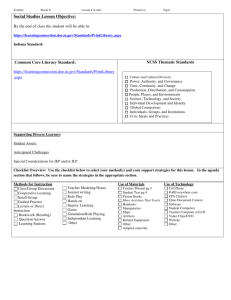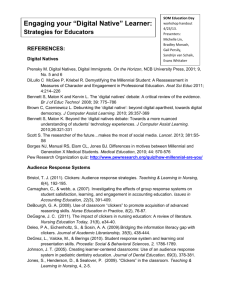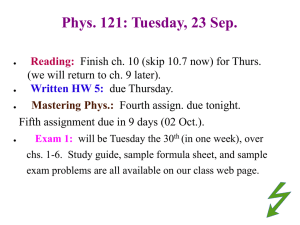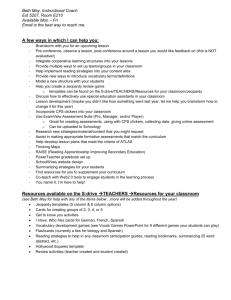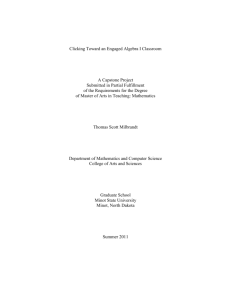Students' Projects in Large Introductory Physics Courses at Ryerson
advertisement
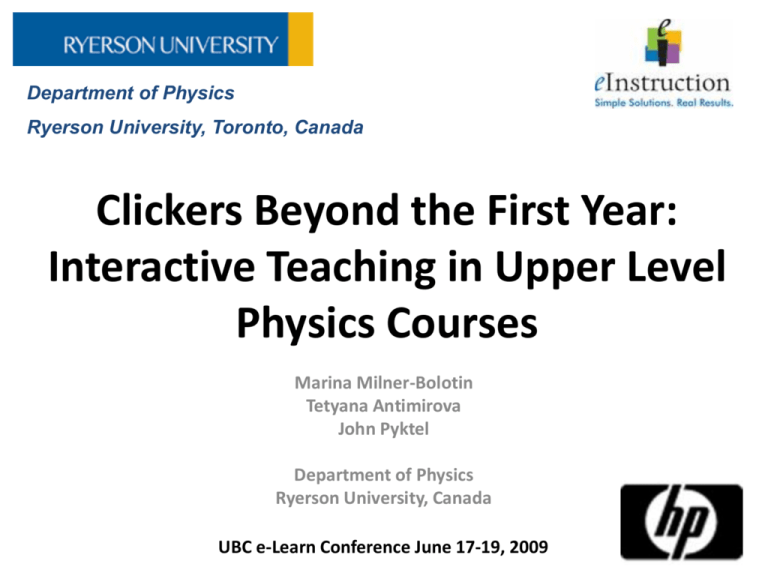
Department of Physics Ryerson University, Toronto, Canada Clickers Beyond the First Year: Interactive Teaching in Upper Level Physics Courses Marina Milner-Bolotin Tetyana Antimirova John Pyktel Department of Physics Ryerson University, Canada UBC e-Learn Conference June 17-19, 2009 1 Have You Ever Used Clickers? A. B. C. D. E. Extensively in lower and upper level courses Extensively but only in lower level courses Very little in lower level courses Have seen them but have never used them Have never heard of clickers but would like to know more F. Have never heard of them and do not care about them 2 Have You Ever Heard of Peer Instruction? A. Yes B. No 3 Seven Principles of Good Undergraduate Education Good practice: 1. 2. 3. 4. 5. 6. 7. encourages student-faculty contact encourages cooperation among students encourages active learning gives prompt feedback encourages time on task communicates high expectations respects diverse talents and ways of learning. Chickering, A.W., and Associates. The Modern American College: Responding to the New Realities of Diverse Students and a Changing Society. San Francisco Jossey-Bass,1981. Also AAHE Bulletin, 1987, 38 (7), pp. 3 -7... And Mary D. Sorccinelli. Research Findings on the Seven Principles, ASHE Reader pp. 368-374 4 Question to Think About? • • • • How can clickers help address these 7 principles? What is the role of clickers in upper level courses? How to design effective questions? How do we share these questions with other faculty? • How to reduce teaching stress when you want to use new technology? • How to convince students active learning is important? 5 Ryerson’s Context • Large urban university located in downtown Toronto • 24,000 day time students enrolled (B. Sc, M. Sc., Ph.D.) • More than 65,400 in Continuing Education • Became a research university in 1992 • Has a large engineering programs • Has a strong focus on teaching and professional education • Has a very multicultural population of students and faculty with significant number of recent immigrants 6 Motivation: Why Clickers? 7 Course Structure and Syllabus • Lectures: Three hours of lectures (studio style) weekly with an instructor • Labs: Two hour lab biweekly with an instructor and a TA • Topics: Special relativity, introduction to quantum mechanics (atomic structure of matter, quantization of light and atomic energy levels) • Assessment: HW assignments, end of term project, class participation (clickers) and group problem solving, final exam 8 Learning Environment (25 2nd year medical physics students) Short lecture presentations by the instructor Multi-faceted assessment: exams, projects, labs, clickers , hw Technology available for every student: clickers and tablets Continuous use of sims, video clips , any available resource 4-5 clicker questions per class tested using computer simulations Classroom physical environment encouraged group work Integrated problem solving and virtual labs 9 Modified Peer Instruction We designed conceptual question for the course : relativity, atomic physics, intro to QM Four-five Clickers questions were asked per 2 hour class Students work in small groups (of 2-3) to figure out conceptual questions The answers to these questions are tested using computer simulations 3/10/2016 10 Example 1a: ST Arrows on a ST Map A. B. C. D. E. F. G. Diagram a Diagram b Diagram c Diagram d Diagram e Diagram f Diagram g Which ST arrow represents two simultaneous events in this RF? ct, m f b g c a d e x, m 11 Example 1b: ST Arrows on a ST Map A. B. C. D. E. F. G. Diagram a Diagram b Diagram c Diagram d Diagram e Diagram f Diagram g Which one of the ST arrows represents two events that happened in the same location in this RF? ct, m f b g c a d e x, m 12 Example 1c: ST Arrows on a ST Map ct, m A. B. C. D. E. g>e>a>c>d>b>f e>g>f>c=b>d>a e>b>c=a>g>f>b e>a>g>c=b>f>d e>g>a>c>d=b>f F. None of the above ranking is correct Rank the ST Arrows by the magnitude of the STI they represent. f b g c a d e x, m 13 13 Example 1d: ST Arrows on a ST Map A. B. C. D. E. F. G. All of them None of them c, e only b, e and d only d only d, a and b a, d and c only Which one of the ST arrows represent the two events that could have had causal relationship (one event caused another one)? ct, m b c a d e x, m 14 Discussion • Your ideas? 15

